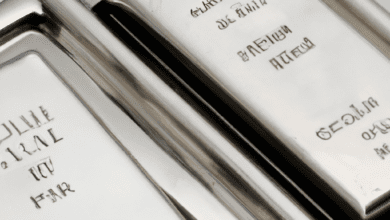Navigating the World of Industrial Metals: Applications, Trading Strategies, and Sustainable Practices for a Greener Future

In today's industrial landscape, metals play a pivotal role in shaping the future of various sectors, including construction, automotive, aerospace, and energy. From the lightweight yet durable properties of aluminum to the extensive applications of copper and zinc, understanding industrial metals is essential for anyone involved in manufacturing or material sourcing. This article delves into the key applications of these metals, highlighting their significance in modern industries and the growing importance of metal recycling for sustainability.
As we explore the trading strategies for base and precious metals, we will provide insights into the dynamics of copper, aluminum, and zinc within the metal commodities market. We will also discuss the implications of sustainable practices in metal production and recycling, emphasizing the future of industrial and rare earth metals in an increasingly eco-conscious world. With the rise of innovative technologies such as 3D printing and the demand for battery metals like lithium, staying informed about metal trends is crucial for investors and industry professionals alike. Join us as we navigate the intricate world of metallurgy and uncover the multifaceted applications and trading opportunities presented by industrial metals.
- 1. Understanding Industrial Metals: Key Applications and Their Role in Modern Industries
- 2. Trading Strategies for Base and Precious Metals: Insights on Copper, Aluminum, and Zinc
- 3. Sustainable Practices in Metal Production and Recycling: The Future of Industrial and Rare Earth Metals
1. Understanding Industrial Metals: Key Applications and Their Role in Modern Industries
Understanding industrial metals is crucial for grasping their significant applications and the vital role they play across modern industries. Industrial metals, which include both ferrous and non-ferrous metals, are essential for various sectors such as construction, automotive, aerospace, and energy.
Aluminum, copper, and zinc are among the most important base metals, each with unique properties that cater to specific industrial needs. For example, aluminum is prized for its lightweight and corrosion-resistant qualities, making it ideal for aerospace metals and automotive applications. Copper, known for its excellent electrical conductivity, is extensively used in electrical wiring and plumbing systems. Zinc, on the other hand, is commonly used for galvanizing steel to prevent metal corrosion, a process vital in construction metals and infrastructure projects.
The role of metallurgy in the production and processing of these metals is fundamental, as it encompasses the extraction and refinement of metal ores through metal mining and metal recycling. The recycling of metals not only helps in conserving natural resources but also plays a crucial role in sustainable metal production. By recycling aluminum, copper, and zinc, industries can significantly reduce their environmental footprint and meet the growing demand for sustainable practices.
In addition to these base metals, the importance of rare earth metals, lithium, platinum, and palladium cannot be overlooked, particularly in the context of energy metals and battery metals. These materials are pivotal in the production of high-performance batteries used in electric vehicles and renewable energy technologies, supporting the shift toward greener energy solutions.
Furthermore, advancements in metal fabrication and 3D printing metals are revolutionizing the way components are manufactured, enabling more efficient production processes and innovative designs. As industries continue to evolve, staying updated on metal trends—such as the growing significance of refractory metals and metal alloys—will be essential for businesses aiming to remain competitive.
In summary, understanding the applications and trading of industrial metals like aluminum, copper, and zinc not only highlights their fundamental role in various sectors but also underscores the importance of sustainable practices and technological advancements in the metal industry.
2. Trading Strategies for Base and Precious Metals: Insights on Copper, Aluminum, and Zinc
Trading strategies for industrial metals such as copper, aluminum, and zinc require a keen understanding of market dynamics, supply and demand, and broader economic indicators. These metals, classified as non-ferrous metals, play a crucial role in various industries, including construction, automotive, and aerospace. Their trading strategies can be tailored to leverage market trends and shifts in consumer behavior.
One effective strategy involves tracking metal trends and understanding how they correlate with macroeconomic indicators. For instance, copper is often viewed as a barometer for economic health due to its extensive use in construction and electrical applications. Traders can analyze housing starts, infrastructure spending, and manufacturing data to anticipate changes in copper prices. Similarly, aluminum, widely used in packaging and transportation, is sensitive to fluctuations in energy costs, given its energy-intensive production process.
Additionally, investors should consider the role of metal recycling in shaping market dynamics. As the demand for sustainable metal production increases, recycled metals become an essential supply source, impacting the prices of base metals like aluminum and zinc. Monitoring regulations and technological advancements in metal recycling can provide insights into future supply trends and pricing.
Another strategy is to diversify investments across different metal commodities. While gold and silver investing typically focus on precious metals, including base metals such as copper and zinc can balance risk and enhance returns. For instance, during economic downturns, precious metals often retain value, while industrial metals may see price declines. However, as economies recover, the demand for industrial metals often rebounds, offering significant upside potential.
Furthermore, traders can explore the increasing relevance of battery metals like lithium and cobalt, especially with the growing focus on electric vehicles and renewable energy technologies. The intersection between energy metals and industrial metals presents unique investment opportunities, as the demand for these materials continues to rise.
In conclusion, effective trading strategies for copper, aluminum, and zinc involve a blend of market analysis, diversification across metal commodities, and an understanding of emerging trends in metal recycling and sustainable production. By staying informed on these aspects, traders can navigate the complexities of the industrial metals market and capitalize on potential growth opportunities.
3. Sustainable Practices in Metal Production and Recycling: The Future of Industrial and Rare Earth Metals
Sustainable Practices in Metal Production and Recycling: The Future of Industrial and Rare Earth Metals
As the world shifts towards a more sustainable future, the practices surrounding metal production and recycling are evolving significantly. Industrial metals such as aluminum, copper, and zinc are essential for various applications, including construction, automotive, and aerospace sectors. However, the environmental impact of metal mining and production has prompted the industry to adopt more sustainable practices.
One of the key trends in sustainable metal production is the increased focus on metal recycling. Recycling metals not only conserves natural resources but also reduces energy consumption and greenhouse gas emissions compared to traditional metal mining. For instance, recycling aluminum saves up to 95% of the energy required to produce new aluminum from ore. This process also plays a crucial role in conserving precious metals and rare earth metals, which are often used in high-tech applications, including electronics and renewable energy technologies.
In addition to recycling, advancements in metallurgy are paving the way for more sustainable methods of metal fabrication. Innovative techniques such as 3D printing metals reduce waste and allow for more efficient use of materials. By utilizing metal alloys designed for specific applications, manufacturers can enhance the performance of construction metals and automotive metals while minimizing their ecological footprint.
Moreover, the development of energy metals, including lithium, platinum, and palladium, is becoming increasingly important. These metals are essential for batteries and other energy-efficient technologies, which are crucial for reducing reliance on fossil fuels. The sustainable mining of these energy metals must be balanced with environmental considerations to ensure that the benefits outweigh the ecological costs.
The future of industrial and rare earth metals will heavily rely on sustainable practices. As demand for base metals continues to rise, the industry must prioritize sustainable metal production and recycling to mitigate the impacts of metal corrosion and resource depletion. This not only aligns with global sustainability goals but also presents new investment opportunities in sectors such as gold investing and silver investing, as investors seek to support companies committed to responsible practices.
As metal trends evolve, stakeholders across the supply chain—from metal mining companies to fabricators—must collaborate to promote sustainability. By adopting environmentally friendly practices, the metal industry can meet the growing demand for metals while ensuring a healthier planet for future generations.
References:
– International Aluminum Institute. (2023). Aluminum's Role in a Sustainable Future. Retrieved from [link]
– World Steel Association. (2023). Steel Recycling. Retrieved from [link]
– U.S. Geological Survey. (2023). Mineral Commodity Summaries. Retrieved from [link]
In conclusion, the landscape of industrial metals is vast and multifaceted, encompassing a wide array of applications that are essential to modern industries such as construction, automotive, aerospace, and energy. Understanding the key applications of metals like aluminum, copper, and zinc not only highlights their role in manufacturing and metal fabrication but also underscores the importance of sustainable practices in metal production and recycling. As we navigate the complexities of trading base and precious metals, it becomes clear that strategic insights are crucial for investors looking to engage in metal commodities such as gold and silver investing.
The future of industrial and rare earth metals lies in innovative practices that prioritize sustainability and efficiency. From metal mining to metal alloys and metal recycling, the industry is evolving to meet the demands of a greener economy. This includes advancements in metallurgy and the exploration of new technologies like 3D printing metals and battery metals, which promise to reshape how we utilize these resources.
As trends continue to shift, staying informed about the dynamics of ferrous and non-ferrous metals, as well as emerging opportunities in refractory metals, will be vital for stakeholders across the board. Ultimately, the integration of sustainable practices will not only enhance the longevity of our metal resources but will also pave the way for a more responsible approach to industrial metal usage. Whether you are an investor, manufacturer, or enthusiast, understanding these trends will be key to navigating the future of metals in our economy.
References:
[Include your sources here following APA citation style]




